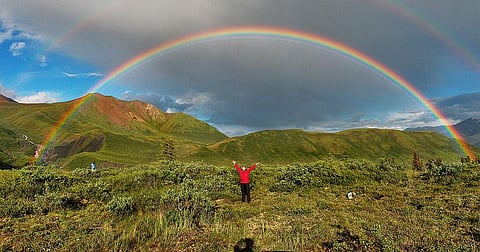

By the next century, parts of the world may see a lot more rainbows, including some African countries and India. Many others might see fewer ones brightening up their sky. But there is no pot of gold at the end, as climate change is impacting precipitation, affecting the skies.
Changes in cloud cover and liquid precipitation due to increased greenhouse gas emissions are projected to lead to a net increase in mean global annual rainbow days, a new study has found. The research was led by a team from the University of Hawaii and published in the journal Global Environmental Change.
Mean days of rainbows are expected to go up globally by 4.0–4.9 per cent in a year by 2100.
A rainbow is a common atmospheric optical phenomenon. It is a multicoloured arc in the sky that results when water droplets refract sunlight. Sunlight and rainfall are, therefore, essential ingredients for rainbows.
Around 21–34 per cent of land areas will lose rainbow days and 66–79 per cent will gain rainbow days under higher emission futures, the research suggested.
Areas that will lose rainbow days are projected to have lower total precipitation by 2100, except those in Central Africa, Madagascar and central South America. All are projected to have more annual dry days and less total annual cloud cover.
India is one of the countries where the number of rainbow days will increase, the study said. African countries like Mali, Niger, Chad, Sudan and Ethiopia are also likely to experience more rain-bow days.
Rainbow gain hotspots are mostly located at higher latitudes or at very high elevations, like the Tibetan Plateau, where warming is predicted to lead to less snow and more rain.
Two rainbow gain hotspots — eastern Borneo and northern Japan — will see overall precipitation increase but more dry days per year.
Human activities such as burning fossil fuels are warming the atmosphere, which changes patterns and amounts of rainfall and cloud cover.
Climate change will, thus, alter the distribution of rainbow occurrence by affecting evaporation and convergence of moisture. This alters patterns of precipitation and cloud cover.
The United States researchers developed a global database of crowd-sourced photographed rainbows to assess how climate change might affect rainbow viewing opportunities. They also trained an empirical rainbow occurrence model and applied it to the present-day climate and three future climate scenarios.
The researchers looked at more than 7,000 verified images of atmospheric rainbows taken between February 2004 and December 2013. The photographs in the study came from every corner of the globe except for Antarctica.
The current likelihood of a rainbow appearance in locations across the planet was calculated. Then it was measured against anticipated changes in rainfall, cloud cover and other factors in order to project future rainbow rates.
The implications of a change in rainbow occurrence are relevant to consider effects on economies, for example, via changes in tourist-based income and property values.
Parallel global changes such as urbanisation and increasing use of technology may also reduce rainbow viewing opportunities.
Alterations to non-tangible environmental attributes due to climate change could be significant and are worthy of consideration and mitigation, the research suggested.